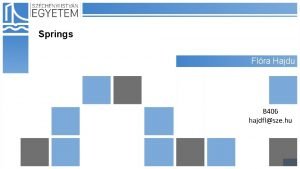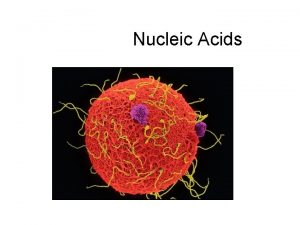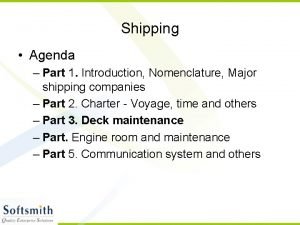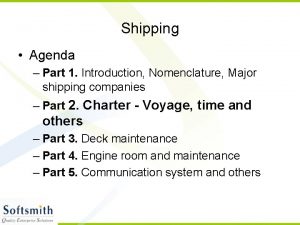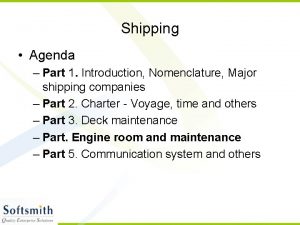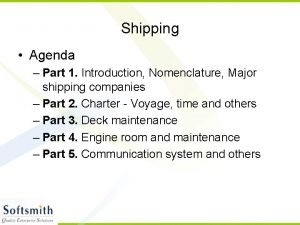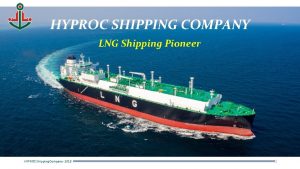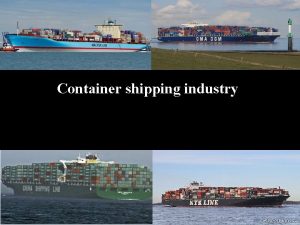Shipping Agenda Part 1 Introduction Nomenclature Major shipping






















- Slides: 22

Shipping • Agenda – Part 1. Introduction, Nomenclature, Major shipping companies – Part 2. Charter - Voyage, time and others – Part 3. Deck maintenance – Part 4. Engine room and maintenance – Part 5. Communication system and others

Communication System The Global Maritime Distress Safety System (GMDSS) is an internationally agreed-upon set of safety procedures, types of equipment, and communication protocols used to increase safety and make it easier to rescue distressed ships and aircraft.

Communication System The system is intended to perform the following functions: alerting (including position determination of the unit in distress), search and rescue coordination, locating (homing), maritime safety information broadcasts, general communications, and bridge-to-bridge communications. Specific radio carriage requirements depend upon the ship's area of operation, rather than its tonnage. The system also provides redundant means of distress alerting, and emergency sources of power.

Communication System • The IMO also introduced Digital Selective Calling (DSC) on HF and VHF maritime radios as part of the GMDSS system. • DSC is primarily intended to initiate ship-to-ship, ship-toshore and shore-to-ship radiotelephone and MF/HF calls. • DSC calls can also be made to individual stations, groups of stations, or "all stations" in one's reach. • Each DSC-equipped ship, shore station and group is assigned a unique 9 -digit Maritime Mobile Service

Communication System Navtex is an international, automated system for instantly distributing maritime navigational warnings, weather forecasts and warnings, search and rescue notices and similar information to ships.

Distress Signal Distress can be indicated by any of the following officially sanctioned methods: • transmitting a spoken voice Mayday (meaning ‘come help me’) message by radio over VHF. • transmitting a digital distress signal by activating (or pressing) the distress button (or key) on a marine radio equipped with Digitial Selective Calling (DSC) over the VHF (channel 70) and/or HF frequency bands. • sending the SOS or Morse code by light flashes or sounds • burning a red flares (either hand-held, foot-held or aerial parachute flare) • emitting orange smoke from a canister • showing flames on the vessel (as from a burning tar barrel, oil barrel, etc) • raising and lowering slowly and repeatedly both arms outstretched to each side • making a continuous sound with any fog signalling apparatus • firing a gun or other explosive signal at intervals of about a minute • displaying a visual signal consisting of a square flag having above or below it a ball or anything resembling a ball (round or circular in appearance)

EPIRBs (emergency position-indicating radio beacons) signal maritime distress. Distress radio beacons, also known as emergency beacons, which aid in the detection and location of ships in distress. When activated, such beacons send out a distress signal which can be detected by satellites and ships will be located.

EPIRB

EPIRB The basic purpose of distress radiobeacons is to get people rescued within the socalled "golden day" (the first 24 hours following a traumatic event) when the majority of survivors can still be saved.

EPIRB - Activation • There are two ways to activate a beacon: manual or automatic • Automatic EPIRBs are water activated, while automatic (impact) activated. Some EPIRBs also deploy; this means that they physically depart from their mounting bracket on the exterior of the vessel (usually by going into the water. ) • For a marine EPIRB to begin transmitting a signal (or "activate") it first needs to come out of its bracket (or "deploy"). Deployment can happen either manually—where someone has to physically take it out of its bracket—or automatically—where water pressure will cause a hydrostatic release unit to release the EPIRB from its bracket. If it does not come out of the bracket it will not activate. There is a magnet in the bracket which operates a reed safety switch in the EPIRB. This is to prevent accidental activation when the unit gets wet from rain or shipped seas.

Pilothouse • A pilothouse is a glass-enclosed room on top of the ship for controlling the same. • The Steering wheel, Compass, Radio communication systems are located here.

Flying Bridge • A flying bridge is a (usually open) area on top or at the side of a pilothouse that serves as an operating station for the officers in good weather or when manoeuvring in port, where good views along the ship sides are important. It is also a raised, usually second storey cockpit on a smaller boat.

Flying Bridge

Ships’ Kitchen (Galley)

Vessel Activity Start Point: a) Vessel location: Port, Latitude, Longitude, time of reporting, ETD (Estimated time of Departure), ETA (Estimated time of Arrival of next port) b) FWGenerator Report c) Fuel Oil Tank Report d) Lube Oil Tank Report e) Safety Certification Report (like SAFCON, Radio Instruments, MARCOM, De. RAT, etc. , ) f) Essential Certificates Validation Checklist which ensures Sailability of Vessel (like Drydock, Hull Report, Rudder Report, Propeller Report, Vessel Soundness Report etc. , ) g) Loading Reports/Un. Loading Reports (Cargo) h) Crew Sign on/Sign Off Report

Vessel Activity Voyage: a) Daily Report: Port, Latitude, Longitude, time of reporting, ETD (Estimated time of Departure), ETA (Estimated time of Arrival of next port), Cruising speed (average for past 24 hours), FWG level, Lube oil levels, Fuel Oil levels, Maintenance activity done in the past 24 hours, any other contingencies. b) FWGenerator Report (Daily) c) Fuel Oil Tank Report (Daily) d) Lube Oil Tank Report (Daily) e) Maintenance Reports done on various components

Vessel Activity Destination: a) Daily Report: Port, Latitude, Longitude, time of reporting, ETD (Estimated time of Departure), ETA (Estimated time of Arrival of next port), b) FWGenerator Report (Daily) c) Fuel Oil Tank Report (Daily) d) Lube Oil Tank Report (Daily) e) Loading/Un. Loading Reports (Cargo) f) Crew Sign on/Sign Off report

CERTIFICATES AND DOCUMENTS REQUIRED TO BE CARRIED ON BOARD SHIPS 1. International Tonnage Certificate 2. International Load Line Certificate 3. International Load Line Exemption Certificate 4. International Oil Pollution Prevention Certificate 5. Oil Record Book 6. International Sewage Pollution Prevention Certificate 7. Garbage Management Plan 8. Garbage Record Book 9. Voyage Data Recorder System – Certificate of Compliance 10. Safety Management Certificate 11. International Ship Security Certificate (or Interim) 12. Cargo Ship Safety Construction Certificate 14 A 13. Cargo Ship Safety Equipment Certificate 15 A 14. Cargo Ship Safety Radio Certificate 16 A 15. Cargo Ship Safety Certificate 16. Dedicated Clean Ballast Tank Operation Manual 15 B

Cargo ships - Classification • Cargo ships are categorized partly by their capacity, partly by their weight, and partly by their dimensions (often with reference to the various canals and canal locks through which they can travel).

Cargo Ship Classification • Small Handy Size: 20, 000 DWT-28, 000 DWT • Handy Size: 28, 000 -40, 000 DWT • Handymax: 40, 000 -50, 000 DWT • Aframax: Oil tankers between 75, 000 and 115, 000 DWT.

Cargo Ships Classification Suezmax the largest size which can traverse the Suez Canal: Ships about 150, 000 tons and typically has a beam (width) of 46 m (151 ft). Panamax, the largest size which can traverse the Panama Canal (generally: vessels with a width smaller than 32. 2 m) Capesize vessels larger than Panamax and Suezmax, which must traverse the Cape of Good Hope and Cape Horn in order to travel between oceans

Cargo Ships Classification • VLCC (Very Large Crude Carrier), Super Tankers between 150, 000 and 320, 000 DWT. • ULCC (Ultra Large Crude Carrier), enormous supertankers between 320, 000 and 550, 000 DWT.
 Liner vs tramp
Liner vs tramp Agenda sistemica y agenda institucional
Agenda sistemica y agenda institucional Meeting agenda introduction
Meeting agenda introduction Purchasing meeting agenda
Purchasing meeting agenda Mentor meeting agenda
Mentor meeting agenda Part whole model subtraction
Part whole model subtraction Part to part ratio definition
Part to part ratio definition Part part whole
Part part whole What is a technical description
What is a technical description Basic bar layout
Basic bar layout The part of a shadow surrounding the darkest part
The part of a shadow surrounding the darkest part Two way anova minitab 17
Two way anova minitab 17 Example of criminal law
Example of criminal law Nomenclature of bolts
Nomenclature of bolts Elastic energy
Elastic energy Basic organic nomenclature packet
Basic organic nomenclature packet Non essential fatty acids
Non essential fatty acids Spring nomenclature
Spring nomenclature Simple key loader manual pdf
Simple key loader manual pdf Wire rope nomenclature
Wire rope nomenclature Shotgun nomenclature
Shotgun nomenclature Chemistry nomenclature
Chemistry nomenclature Nucleotide nomenclature
Nucleotide nomenclature

















